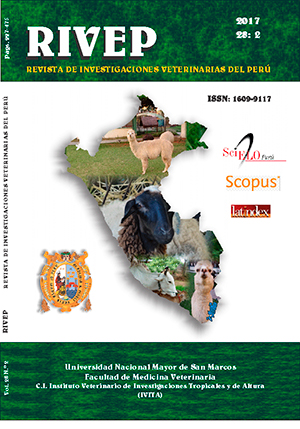Antibiotic resistance of enterobacteria isolated from monkeys (Ateles, Callicebus and Lagothrix) in semi-captivity in a rescue centre, Peru
DOI:
https://doi.org/10.15381/rivep.v28i2.13073Keywords:
enterobacteriaceae, monkeys, Ateles, Callicebus, Lagothrix, resistance, antibioticsAbstract
Several genera and species of nonhuman primates can be found in Peru. Among them, Ateles belzebuth, Ateles chamek, Callicebus oenanthe, Lagothrix cana and Lagothrix lagotricha. These species according to the IUCN Red List are in the threatened category. The aim of this study was to determine the antibacterial sensitivity profile of enteric isolates from Ateles, Callicebus and Lagothrix raised in semi-captivity. Sampling was performed by rectal swab in 56 nonhuman primates in the Center for Rescue and Rehabilitation of Primates Ikama Peru. Isolation and bacterial identification was performed using a standard protocol and bacterial sensibility by the Kirby-Bauer technique. A total of 106 bacterial strains of the family Enterobacteriaceae were isolated, where the most prevalent species was Escherichia coli (45.5%, 45/106). The isolates showed greater resistance to cephalothin (46.2%), amoxicillin - clavulanate (31.1%), tobramycin (30.2%) and tetracycline (24.5%).Downloads
Downloads
Published
Issue
Section
License
Copyright (c) 2017 Claudia Medina G., Siever Morales C., Miluska Navarrete Z.

This work is licensed under a Creative Commons Attribution-NonCommercial-ShareAlike 4.0 International License.
AUTHORS RETAIN THEIR RIGHTS:
a. Authors retain their trade mark rights and patent, and also on any process or procedure described in the article.
b. Authors retain their right to share, copy, distribute, perform and publicly communicate their article (eg, to place their article in an institutional repository or publish it in a book), with an acknowledgment of its initial publication in the Revista de Investigaciones Veterinarias del Perú (RIVEP).
c. Authors retain theirs right to make a subsequent publication of their work, to use the article or any part thereof (eg a compilation of his papers, lecture notes, thesis, or a book), always indicating the source of publication (the originator of the work, journal, volume, number and date).










